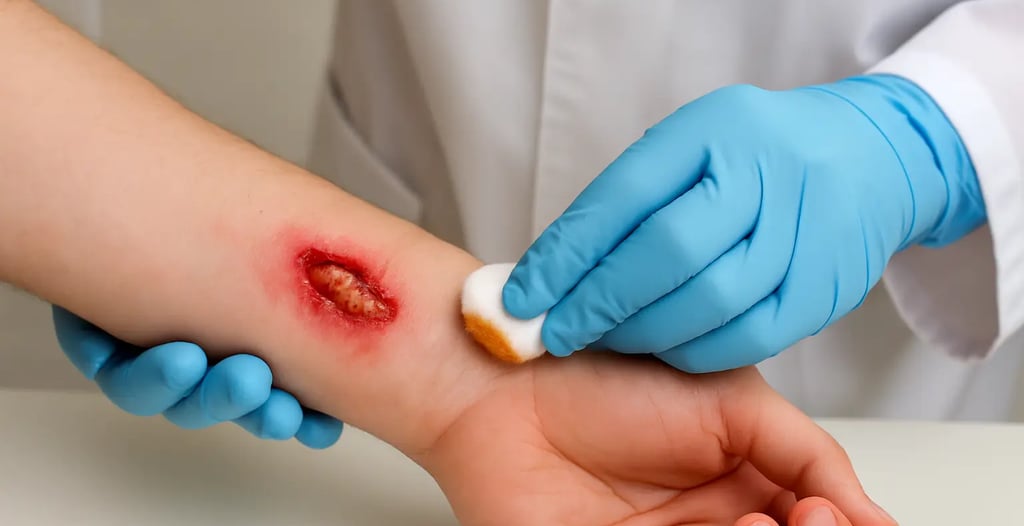Dog Bite Infections: Symptoms, Treatment Options & Prevention Tips
Discover the symptoms, treatments, and prevention of dog bite infections. Learn how to recognize early signs, avoid complications, and protect your health.


Dog Bite Infections: Symptoms, Treatment, Complications, and Prevention
Dog bites are more than just surface-level injuries—they can lead to serious infections if not properly treated. Recognizing the early symptoms, understanding treatment options, and taking steps to prevent dog bites can significantly reduce the risk of complications. This article will help you understand how to identify dog bite infections, seek proper care, and avoid future incidents.
Recognizing the Symptoms of Dog Bite Infections
Early detection of infection after a dog bite is critical for fast recovery and to avoid serious health risks. Common signs of dog bite infection include:
Redness and swelling around the wound
Pain that worsens over time
Warmth at the bite site
Pus or discharge from the wound
If the redness begins to spread or the pain increases instead of improving, these are early signs that an infection may be developing.
Systemic Symptoms That Signal a More Serious Infection
In some cases, the infection can spread and trigger systemic symptoms such as:
Fever
Chills
Excessive sweating
Fatigue
Swollen lymph nodes, especially near the affected area
These symptoms suggest the infection may be affecting the entire body and require immediate medical attention. If ignored, they can lead to dangerous conditions like sepsis or abscess formation.
Effective Treatment for Dog Bite Infections
Timely and proper treatment is key to preventing complications from dog bite infections. Here’s what you should do if bitten:
1. Immediate First Aid
Clean the wound immediately with soap and water.
Disinfect with an antiseptic like iodine or hydrogen peroxide.
Cover the bite with a clean, sterile bandage.
2. Medical Evaluation
Seek medical help if:
The wound is deep or bleeding heavily
You notice signs of infection like pus or swelling
You haven’t had a tetanus shot in the last 5 years
3. Antibiotic Treatment
Doctors often prescribe oral antibiotics such as amoxicillin-clavulanate to prevent or treat infection. In severe cases, IV antibiotics may be necessary.
4. Home Care & Monitoring
Keep the wound clean and dry
Change the dressing daily
Watch for signs of worsening infection such as spreading redness or fever
Prompt medical treatment and good hygiene practices greatly increase the chances of full recovery without complications.
Potential Complications from Untreated Dog Bite Infections
Ignoring a dog bite infection can lead to serious and sometimes life-threatening complications, including:
1. Abscess Formation
An abscess is a pocket of pus caused by a bacterial infection. It’s painful and may require surgical drainage.
2. Cellulitis
This is a bacterial skin infection marked by red, warm, and swollen skin. Cellulitis can spread quickly and may become life-threatening if bacteria enter the bloodstream.
3. Sepsis
Sepsis is a severe, whole-body inflammatory response to infection. It requires urgent hospital treatment and may involve multiple organ systems.
4. Long-Term Effects
Permanent scarring
Nerve damage or loss of function in the affected area
Emotional trauma, including anxiety or PTSD in severe cases
Preventing these complications starts with early recognition and fast, appropriate medical care.
How to Prevent Dog Bites and Related Infections
Preventing dog bites is the best way to avoid infections altogether. Whether you’re a pet owner or frequently around dogs, these tips can help:
For Dog Owners:
Train and socialize your dog from a young age
Avoid aggressive play or rough treatment
Keep up with vaccinations and regular vet visits
Use a leash in public spaces
For the Public:
Do not approach unfamiliar dogs without the owner's permission
Watch for signs of aggression: growling, showing teeth, or raised fur
Teach children how to interact safely with dogs
Avoid disturbing dogs while they are eating, sleeping, or caring for puppies
Importance of Vaccination:
Always ensure your dog is vaccinated against rabies and other transmissible diseases. This not only protects your pet but also reduces the risk of disease transmission to humans.
Final Thoughts
Dog bite infections are medical emergencies that require prompt attention. Early signs such as redness, swelling, or pus should never be ignored. With proper wound care, timely antibiotic treatment, and preventive strategies, the risk of serious complications can be greatly reduced. Stay informed, act quickly, and always prioritize safety—both for yourself and the animals around you.
Frequently asked questions
Q1. What are the first signs of a dog bite infection?
A: The first signs include redness, swelling, warmth, and increasing pain around the bite area. Pus or discharge and systemic symptoms like fever may also appear.
Q2. How soon should I see a doctor after a dog bite?
A: You should see a doctor immediately if the wound is deep, shows signs of infection, or if the dog’s vaccination status is unknown. A tetanus shot or antibiotics may be required.
Q3. Can a dog bite cause serious health problems?
A: Yes. Untreated dog bites can lead to cellulitis, abscesses, nerve damage, or life-threatening sepsis. Prompt medical treatment is essential.
Q4. How do I prevent a dog bite from getting infected?
A: Clean the wound with soap and water, apply an antiseptic, and keep the area covered with a sterile bandage. Watch for signs of infection and consult a doctor if needed.
Q5. Are antibiotics always necessary for a dog bite?
A: Not always, but if there’s a high risk of infection or visible symptoms (e.g., swelling, pus), doctors often prescribe oral or IV antibiotics.
